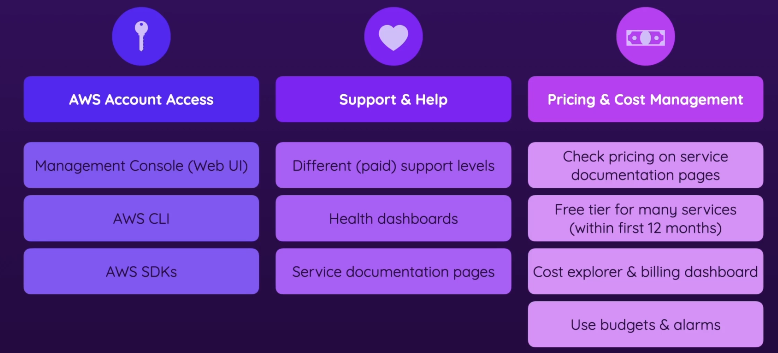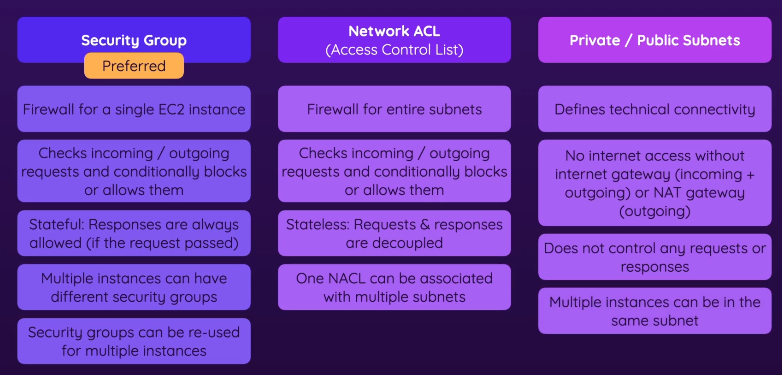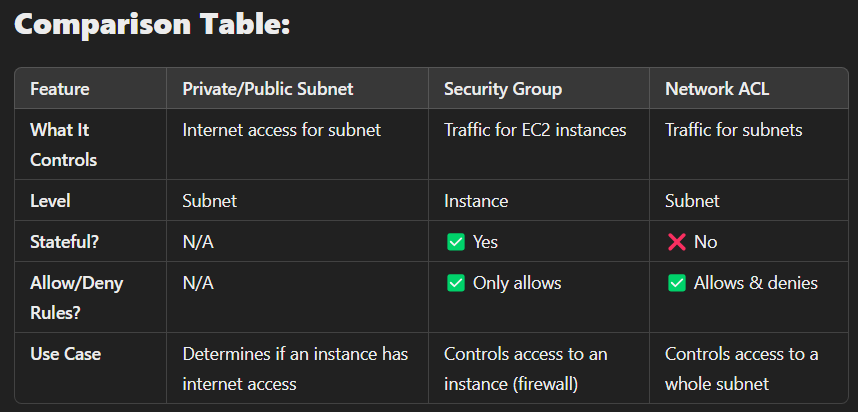- Great sources
Getting Started
- Basics - Course Supplement
- What is AWS?
- AWS is a company - Amazon Web Services, a subsidiary of Amazon (amazon.com)
- It is a Cloud Computing Services Provider
- Cloud Computing
- AWS Infrastructure (Regions, AZs, Edge locations)
- Cloud Computing Responsibility
- Disaster recovery
- Self Service & Managed Services
- Two main kinds of services
- You can mix & match different services as you need
- Self Service
- Do it yourself
- EC2 - configure and launch a server → only the hardware is managed by AWS
- Managed Services
- AWS manages the hard parts.
- Partially configurable
- Can be used together with other services (self-service)
- Two main kinds of services
- Service categories
- https://aws.amazon.com/ > products
- some services do show up multiple times in different categories
- some listed things aren’t actually services but features (lol)
- Group

- The groups solve different problems & do different workloads
- https://aws.amazon.com/ > products
Accessing & Using AWS Services
Security
- Diagram
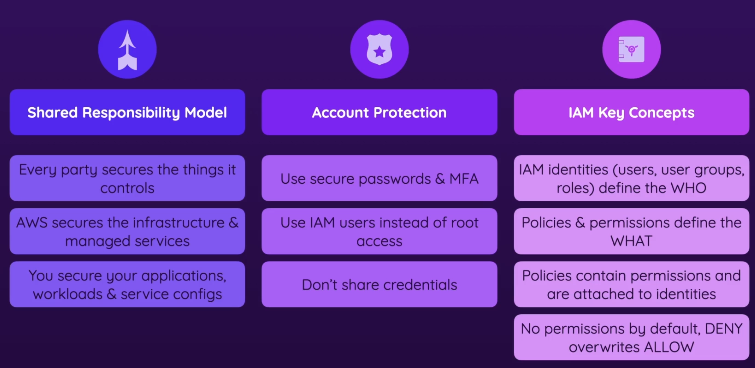
- Diagram (security matters)
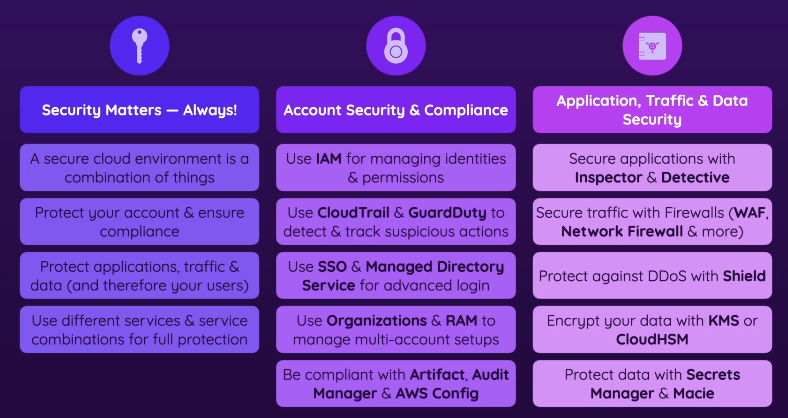
- Diagram (from AWS)
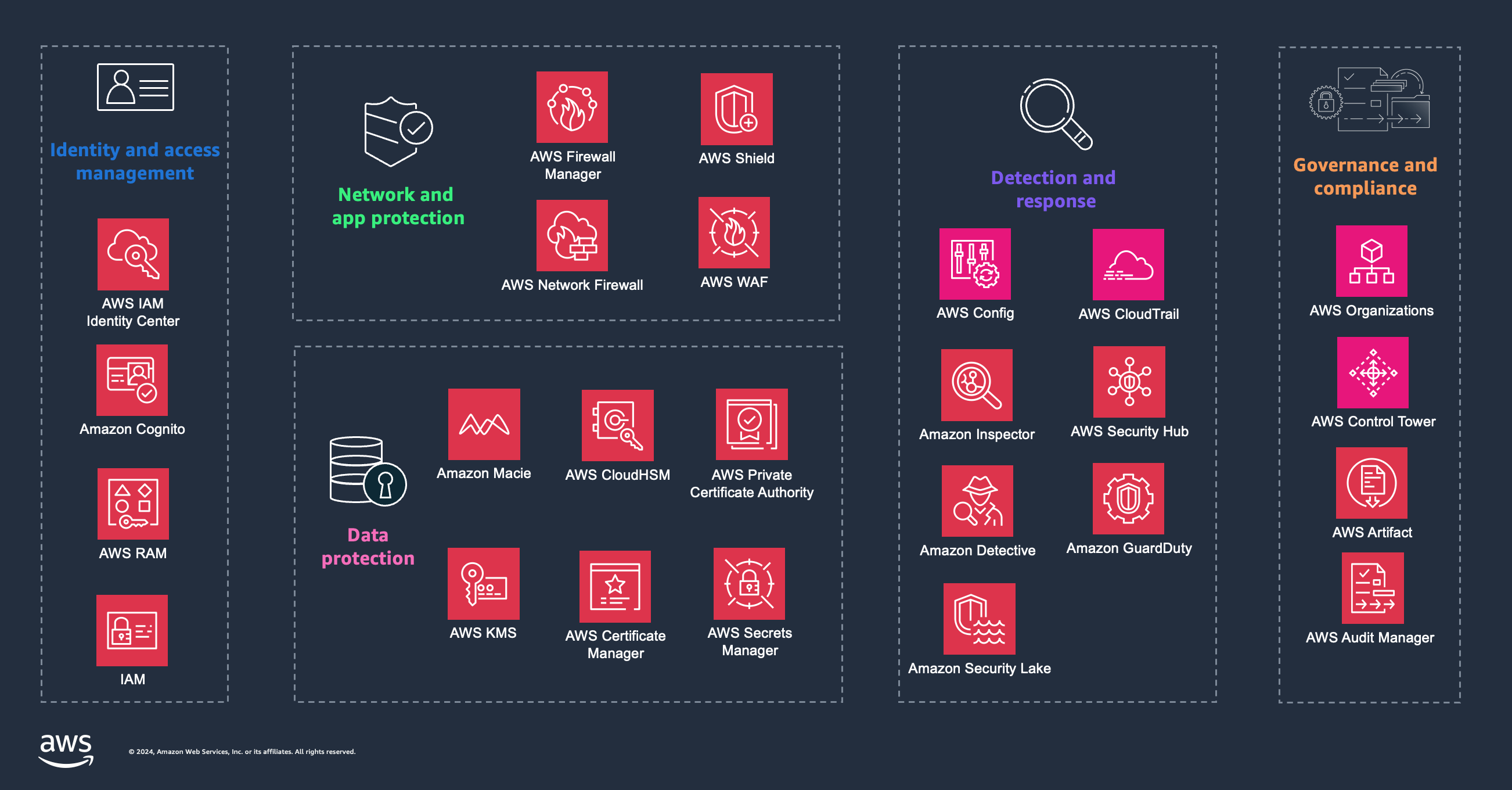
- Security matters (EVERY IMPORTANT SERVICE IS HERE, ITS LONG)
- The Shared Responsibility Model, Protecting your account
- Permissions & Access Control (IAM)
Compute
- diagram - compute, EC2

- diagram - serverless, containers

- Compute services
- Containers
- Serverless Service
- High Performance Computing
VPCs & Multiple EC2 Instances
- diagram
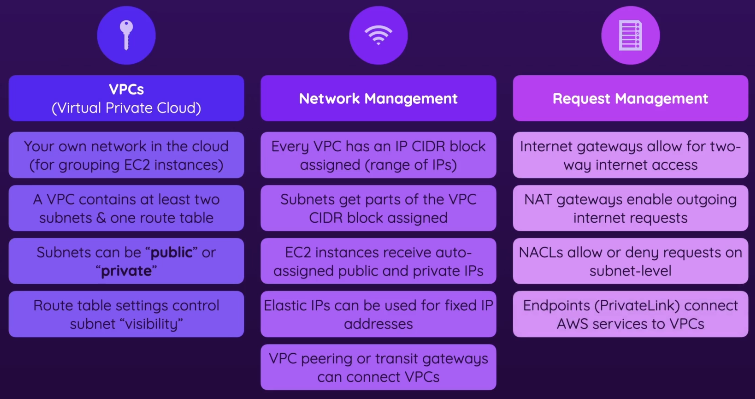
- Virtual Private Cloud (VPC)
- Subnets, gateways, connecting 2 or more VPCs, VPC Endpoints & AWS PrivateLink
- IP Ranges (CIDR Blocks)
- public/elastic IP addresses
- Controlling network access
Dynamic Scaling & Load balancing
- diagram
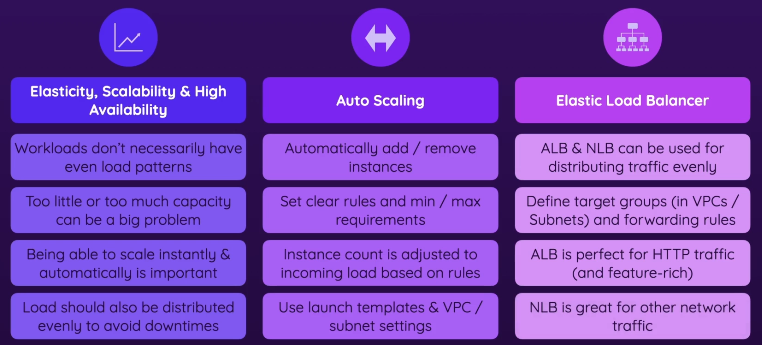
- Dynamic Scaling
- EC2 Auto Scaling - add/remove # of instances
- Elastic Load Balancer (ELB) - distributes traffic evenly
File Storage/Databases
- File storage
- diagram (file storage, EBS, EFS)
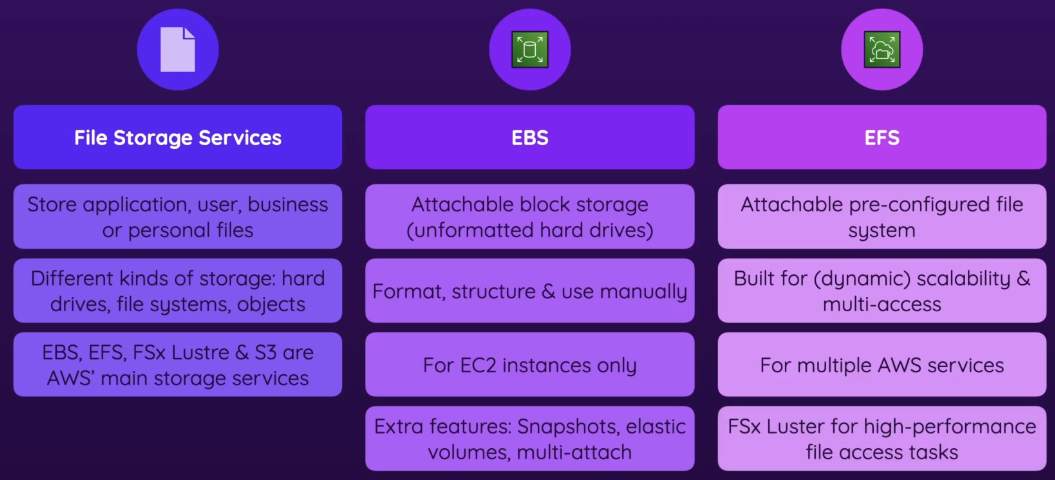
- diagram (S3)
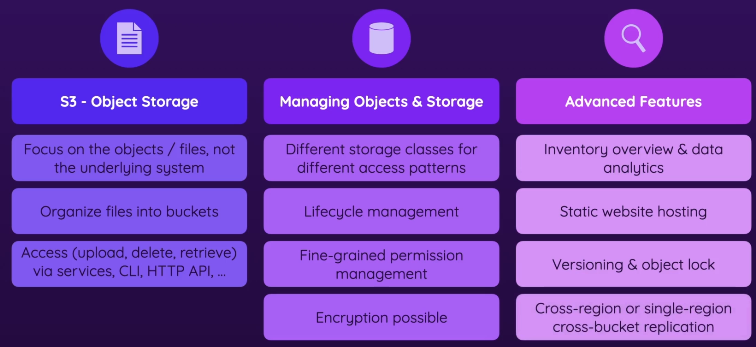
- EBS (Elastic Block Store)
- S3 (Simple Storage Service)
- EFS (Elastic File System)
- FSx Lustre & Others
- diagram (file storage, EBS, EFS)
- Databases (AWS)
- diagram
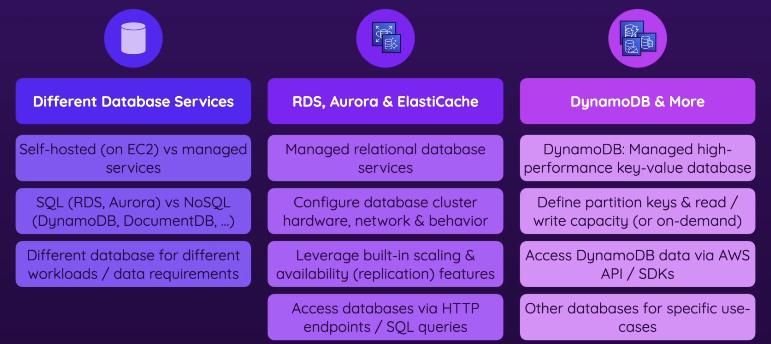
- For services like RDS, Aurora, ElastiCache, you use query languages
- For special services like DynamoDB, you use AWS commands
- RDS (Relational database service)
- RDS Multi-AZ
- DynamoDB
- ElastiCache
- diagram
Global Networking
- diagram

- VPC has nothing to do with delivering content, just managing your network in the cloud
- R3 - registering domains and forwarding domains to certain services
- DNS (Domain name systems)
- CDN (Content Delivery Network)
- Speed Boosts
- ACM (AWS Certificate Manager)
APIs
- diagram
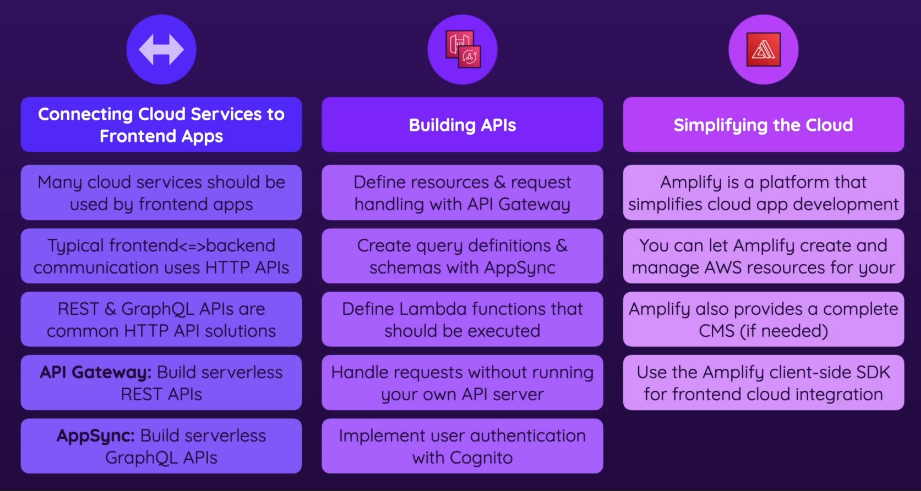
- Why APIs
- API Gateway - REST APIs
- AppSync -GraphQL APIs
- Cognito - user authentication in backend
- Amplify - simplification platform
Simplification / Standardization
- diagram
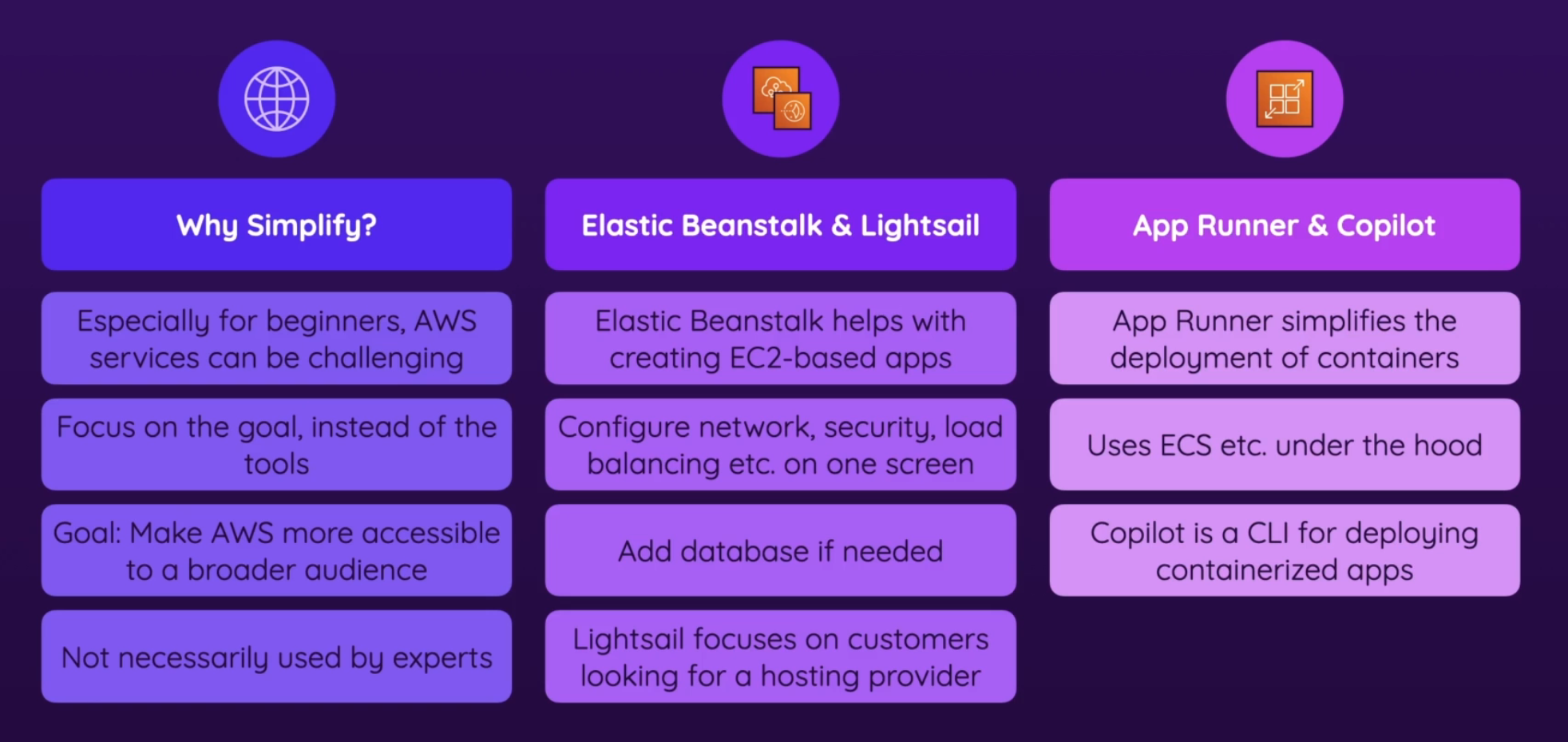
- Simplification Services
- Elastic Beanstalk - application deployment
- LightSail - EC2
- AppRunner, (AWS) Copilot - Container deployment
- CodeStar - simplified CodePipeline
- Standardized service solutions
- Standardizing Service Implementations
- Service Catalogue, Proton, Launch Wizard
- RAM (Resource Access Manager) - sharing resources
- Standardizing Service Implementations
App Integration
- diagram
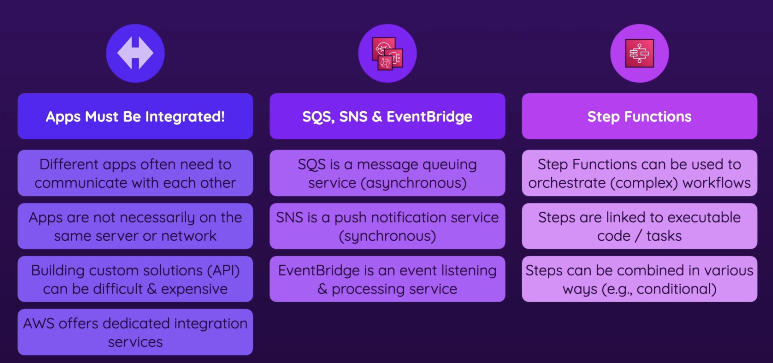
- App integration
- Services - cross application
- SQS (Simple Queue Service) - asynchronous
- SNS (Simple Notification Service) - synchronous
- EventBridge
- CloudMap
- Predefined step
- Services - emails to users
- Other services
Monitoring workloads
- diagram
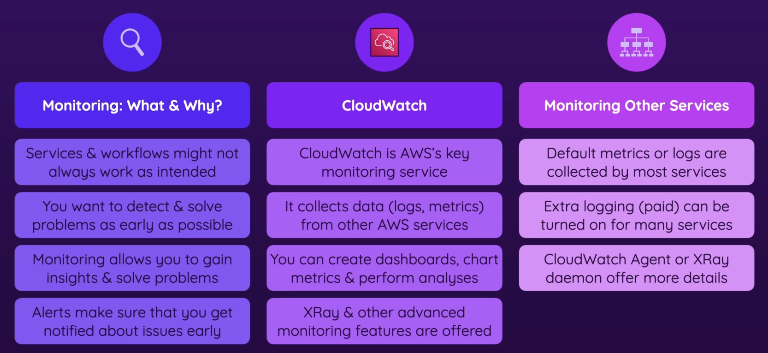
- Monitoring workloads
- Services
Managing compute resources w/ scale
- diagram

- AWS Batch - Planning & Performing batch jobs
- Compute Optimizer - Optimizing Compute Resources
- Systems Manager - Managing large scale systems
- Others
Cloud migration & Hybrid cloud
- Cloud migration
- Key Migration services
- migration hub, application migration service, db migration service, datasync, transfer family, snow family
- Key Hybrid Cloud Computing Services
- outposts, snow family, ecs/eks anywhere, storage gateway, DataSync & transfer family, systems manager
- Connecting to cloud
- public internet, vpn, AWS Direct Connect
Data Analytics
- Data Analytics
- Services (long..)
- high frequency data ingestion
- Storing Data meant to be analyzed
- AWS Data Lakes & Warehouses
- Redshift - storing & analyzing data
- Data processing & transformation
- Data query & Analyzing data
- Searching / visualization
Cloud Management
- diagram - Service & workload configuration
- central: Systems Manager
- share templates/resources: Service Catalogue and Proton
- control service configuration: CloudFormation & CDK,
- AWS Config - checking for violation
- License Manager
- Services
- AWS Organization (Multi-Account Environments)
- Control Tower
- CloudFormation & CDK
- AWS Config - checking for violation
- License Manager
Developer Tools
- A typical workflow
- Services
- Cloud9 - cloud-based IDE
- CodeCommit - AWS’s Git repository
- CodeBuild & CodeArtifact - running tests- & running applications
- CodeDeploy - deploy code to services
- CodePipeline & CodeStar - Automate this entire pipeline
- Others
- CodeGuru & DevOpsGuru - ML + recs
- AWS Toolkit for VSCode
- SageMaker Pipelines - automatic CI/CD services for ML workflows
Other tools
- Not important for the exam
- AI+ML services
- IoT Services
- Running code/services on very simple devices (fridges, keychains, etc)
- Business applications
- Not about doing something in cloud/build apps, but about leveraging AWS software
- ex. Amazon Chime is alternative to Slack
- Media services
- processing media in the cloud, can be used to build products
- can be used to stream video / build your own streaming service
- inject ads into vid, encode vids into cloud, store vid assets in cloud, etc
- Amazon Connect
- cloud-based contact center service
- lets businesses set up customer service call centers with features like voice, chat, AI-driven automation, and analytics
Best practices
- The Well-Architected Framework
- The Well-Architected Tool
- The Trusted Advisor Tool
- Acceptable Use Policy
Beyond AWS Services
-
Practicing for the exam
- practice exam in AWS course
- official exam guide + sample questions
- Look briefly over the FAQs + docs for key services
